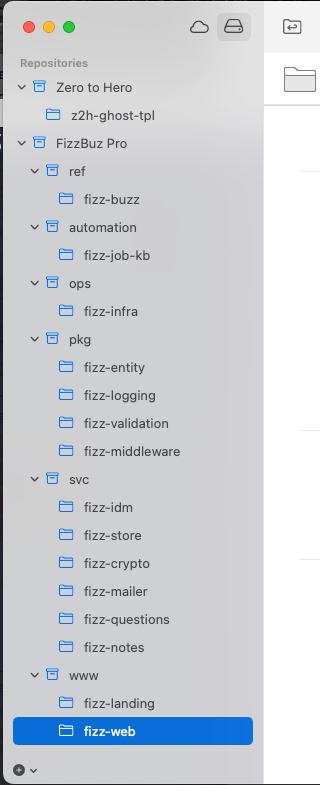
Go shopping for microservices.
Introduction
In this series, we will create use case articles about FizzBuzz Pro. Those articles will outline the entire architecture design, proof of concepts, and development of FizzBuzz Pro and Zero to Hero.
While we are working hard creating stuff, you’ll feel right in the kitchen 👩🍳.
This is one of those articles where I’m sharing the repository structure and what kinds of microservices FizzBuzz Pro will have.
Repositories
Here is how I’ve organized the current repositories in Tower:

Current Zero to Hero and FizzBuzz Pro repositories.
Most of the repositories are empty right now; however, the picture above at least gives some structure about which services we will initially design.
Let me briefly go over those repositories:
Zero to Hero Design
z2h-ghost-tpl: The theme of this very page that you are looking at. Zero to Hero is a Ghost-based learning management system. This repository contains a customized fork of Casper, the default Ghost theme.
FizzBuzz Pro Knowledge Base
fizz-buzz: This is where the meat of FizzBuzz Pro will be. It will have study notes, questions, answers, strategy recommendations… anything you need to become a better competitive programmer to nail that coding interview.
FizzBuzz Pro DevOps and Automation
fizz-job-kb: This is a Kubernetes Job that fetches the content from the abovefizz-buzzrepository, does some preprocessing and conversion on it and uploads it to an S3 Bucket for some of the microservices to pre-populate their local caches using Init Containers.fizz-infra: Infrastructure-related configurations, descriptors, manifests, scripts. This repository will primarily be used by the [CI/CD][ci-dd] pipeline.
FizzBuzz Pro Libraries
fizz-entity: Data models and entities that all of the microservices share in common.fizz-logging: Common logging utilities that all of the microservices share.fizz-validation: Common validation and sanitization methods that all the microservices share.fizz-middleware: HTTP security and tracing middleware that all the microservices use in common.fizz-app: Contains microservice application related middlewares and utilities likeMonitor(),ListenAndServe()which decorate and augment existing functionality.
FizzBuzz Pro Microservices
fizz-idm: Identity management, users, password reminders, account activation, and the like.fizz-store: Payment gateway integration.fizz-crypto: Anything cryptography-related: encryption, decryption, token generation, token validation, etc.fizz-mailer: Sends emails from[email protected]to places.fizz-questions: A microservice to serve questions and answers.fizz-notes: A microservice that serves additional notes and articles.
External Services to Use
We’ll be leveraging third-party “as a service” solutions as much as possible instead of reinventing the wheel so that we can focus on… well… things like… actually providing some value.
I haven’t decided on all of them yet, so things may change down the line. And here are the initial list of services that I think we’ll leverage.
- MongoDB Atlas for both the database and also the caching layer.
— I doubt it, but if caching becomes a more significant issue, we might launch an Amazon ElastiCache cluster too. Still, there’s no need to use it unless there’s a significant lag that a caching layer can solve. - Mailgun for sending system emails and newsletters.
- Amazon Elastic Container Registry to push microservice container images.
- Amazon EKS for a managed Kubernetes cluster. We don’t strictly need Kubernetes, but it’ll be fun to deploy the infrastructure onto a Kubernetes cluster.
- Amazon S3, along with Amazon CloudFront to serve the static web apps.
- CloudWatch and Amazon Container Insights for monitoring.
— Later on, we might consider a solution like DataDog for better visibility and observability. Still, we’ll initially start with what the AWS ecosystem already provides us. - Papertrail for log aggregation.
— Related to that, Honeybadger for catching and reporting errors.
Playlist
▶ FizzBuzz Pro Repositories
Conclusion
This is a long journey, and there’s a lot to do. My first focus is to develop a “minimally delightful” user experience as fast as possible.
I’ll share the entire journey with y’all with all of the design, architecture, and business decisions with complete transparency: There will be lots of use case articles and videos to cover how FizzBuzz Pro is evolving.
Aside
Before I forget, the source code will be private; but I’ll share enough of it to give you ideas and pointers to use as a starting point if you want to create a similar service.
That being said, that’s all there is to it for today.
Next, I think I’ll start creating some of these services locally. I’ll then ensure that they run on a local Kubernetes cluster before deploying them to a staging EKS Kubernetes cluster.
And until then… may the source be with you 🦄.